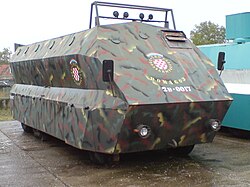This article needs additional citations for verification .(April 2019) |

An improvised fighting vehicle is an ad hoc combat vehicle resulting from modified or upgraded civilian or military non-combat vehicle, often constructed and employed by civilian insurgents, terrorists, rebels, mobsters, guerrillas, partisans, drug cartels, criminal organizations or other forms of non-state militias and irregular armies. Such modifications usually consist of grafting improvised armour plating and fixed crew-served weapons such as heavy machine guns or antiaircraft autocannons mounted onto the back of a utility vehicle or pickup truck.
Contents
- Early use
- Daimler-Guinness Armoured Lorries
- Piłsudski's Tank
- World War II
- SAS jeeps
- British home guard
- Soviet tractor tanks
- Kubuś
- Modern times
- Technicals
- Gun trucks
- Narco tanks
- ISIS and YPG armored vehicles
- Ukrainian and Russian improvised armoured vehicles
- See also
- References
Various militias and official militaries have improvised such vehicles ever since the introduction of the first automobiles into military service. During the 1910s and 1920s, the absence of a doctrine for the military use of automobiles or of an industry dedicated to producing them led to a great deal of improvisation in the creation of early armored cars and similar vehicles.
In the 1930s and 1940s, despite the advent of arms industries producing armored fighting vehicles in many countries, several armies still resorted to using ad hoc contraptions, often in response to unexpected military situations, or as a result of the development of new tactics for which no available vehicle was suitable.
The construction of improvised fighting vehicles may also reflect a lack of means for the force that uses them. This is especially true in developing countries, where various armies and guerrilla forces have used them (e.g. during the Toyota War), as they are more affordable and accessible than military-grade combat vehicles.








